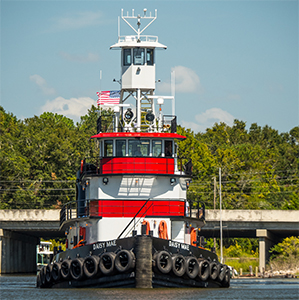Rodriguez Shipbuilding has made shallow-draft, triple-screw tugboats something of a specialty. Its latest product is Daisy Mae, built for Coeymans Marine Towing (CMT).
The 83-foot tugboat is based at the Port of Coeymans 10 miles south of Albany. It’s primarily used for moving material to New York City more than 100 miles to the south.
“The bulk of the business is aggregate, but we are getting into everything,” said Mark Pearson, a senior captain and vessel manager for CMT.
Rodriguez Shipbuilding of Coden, Ala., delivered the 3,300-hp vessel in fall 2017. Yard owner Joe Rodriguez designed it with input from Pearson and Matt Hofmann, CMT’s vice president of operations.
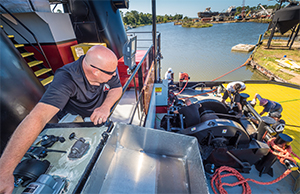 |
|
Capt. Mark Pearson operating the aft winch controls on the Markey TDS-24 stern winch. |
Originally, Daisy Mae’s power was to be provided by two Cummins QSK38 engines providing 2,600 total hp. But because the Hudson ices up during the winter, the Coast Guard requires tugs working on the river to have at least 3,000 hp.
Rodriguez estimates the two Cummins mains turning propellers in Kort nozzles would produce more than 3,000 hp, albeit uncertified. Increasing horsepower would meet Coast Guard minimums during ice conditions, but the question was whether to incorporate larger engines or a third main.
Drawing on his triple-screw expertise, Rodriguez suggested tucking a 750-hp Cummins QSK19 engine between the two larger mains. The configuration also includes Kort nozzles, which can boost thrust by 25 percent or more. Daisy Mae’s overall bollard pull is 50 tons, and Rodriguez believes it rivals a 4,000-hp tug.
Pearson acknowledged some “back and forth on the issue” of adding a third engine. But he said the redundancy offered by a third main was the deciding factor. “We would have the ability to finish a job in the case of an engine going down,” he said.
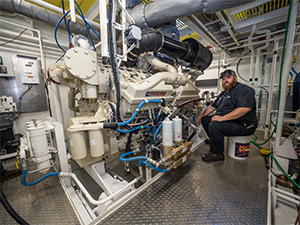 |
|
Cummins Marine engine technician Chris Stealham fine-tunes the Cummins QSK38 engine aboard Daisy Mae. |
All three engines are equipped with shaft brakes, allowing for different power scenarios depending on the season, the job and other factors. For example, Pearson said the smaller engine likely won’t be used when the Hudson is clear of ice. However, it could be used in place of a larger main for transits and harbor jogging to save fuel and engine wear.
The Cummins QSK38 mains are coupled to Twin Disc MGX-5321 deep-case gears at a 5.96:1 ratio, and shafted to Kahlenberg stainless-steel, four-bladed, 75.25-by-80-inch propellers. The Cummins QSK19 is coupled to a Twin Disc MGX-5222 gear at a 6.1:1 ratio and shafted to a Kahlenberg stainless-steel, four-blade, 65.25-by-72-inch propeller.
The third engine also allowed for smaller wheels and less draft, resulting in a 10-foot molded depth. Depending on load conditions, the tug can operate in 8 feet of water. Another benefit: Rodriguez argues tugboats with a triple-screw configuration can rival z-drive tugs for maneuverability at a much lower price.
“Daisy Mae is set apart from other tugs for a few reasons,” Pearson said. “She has four flanking rudders, giving her river towboat maneuverability in a coastal model bow tugboat.”
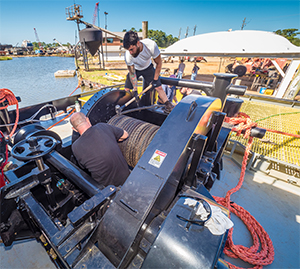 |
|
Second AB Michael Grooms and engineer Raymond Churchill clinching the cable as it reels into the Markey towing winch. |
The model bow design gives Daisy Mae better sea-keeping abilities than a conventional push-knee riverboat. But the tug, fitted with steering rudders on each of the mains, has the maneuverability of a riverboat. The combination of flanking rudders, foil-shaped steering rudders, shaft brakes, Kort nozzles and the muscular horsepower of the port and starboard mains on a beamy hull results in a nimble, responsive boat.
“With the three-screw tug, we have three steering rudders for main propulsion and flanking rudders for the two outside wheels. Because they are in Kort nozzles, we use the flanking rudders to direct the flow of water from the wheels. When you’re landing a 600-foot tow with a fair tide, the flanking rudders work very well.”
The riverboat characteristics are well suited to the river currents and cramped harbors on the Hudson and in New York City. On the other hand, the model bow was of great benefit on Daisy Mae’s maiden voyage shortly after Hurricane Maria ravaged Puerto Rico.
After departing the Rodriguez yard, Daisy Mae made Port Canaveral, Fla., Charleston, S.C., and then Hampton Roads, Va., where the tug picked up a barge at Newport News. From there, the vessels headed south to West Palm Beach, Fla., where the barge took supplies for Puerto Rico’s relief effort. The tow primarily had four-wheel-drive trucks carrying tanks of fuel, bucket trucks and some containers of supplies.
 |
|
Daisy Mae’s lower pilothouse is equipped with advanced Simrad electronics. |
“It was a five-and-a-half-day trip, one way,” Pearson reported in mid-November, as he prepared for a second run. “She has proven herself a sturdy sea boat, and she is a comfortable boat because of the beam-to-length ratio. We are working out the best fuel burn with the three engines — which ones to have running for the best fuel economy.”
“Aside from a couple of initial minor bugs, there are no major issues with the boat,” he added. “Everybody likes her. And she is a nice, heavy sea boat for her size. And I love my single-drum, three-speed Markey winch for towing.”
Pearson gave a nod to Rodriguez Shipbuilding for having turned out a quality vessel in a short time frame. “Joe’s employees show pride in their work in every aspect of this build and have exceeded our expectation for what to expect from a shipbuilder and a new vessel for our fleet.”
The tug is equipped with a Markey TDS-24 towing winch wound with 2,000 feet of 1.5-inch wire. For pushing in a model bow makeup, it has two Patterson 40-ton deck winches with 1.5-inch Plasma line run through sheaves on the aft deck.
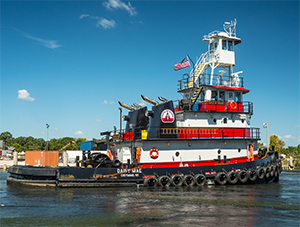 |
|
Daisy Mae has a 41.5-foot height of eye from the upper pilothouse. |
In 2001, Carver Laraway purchased the Port of Coeymans from the P&M Brick Plant and redeveloped the 400-acre site into a thriving, privately owned marine terminal. In addition to Daisy Mae, the CMT fleet includes the 2,200-hp Helen Laraway, the 1,200-hp push tugs HR Pike and CMT Otter, and the 2,600-hp Mr. Jim.
Daisy Mae has a 41.5-foot height of eye from the upper pilothouse, which sits over the radars and hinged mast on struts bolted to the top of the bridge. The structure can be removed if an air draft issue arises on, for example, lower bridges spanning New York State’s many canals.
But as Rodriguez said, “Daisy Mae can clear 45 feet so it shouldn’t be a problem."

